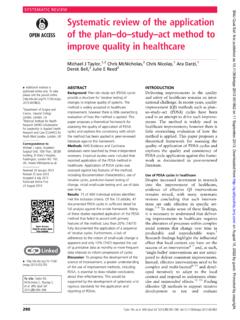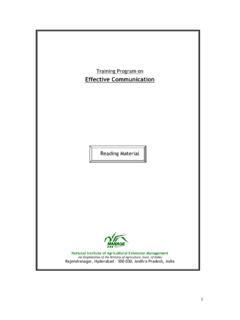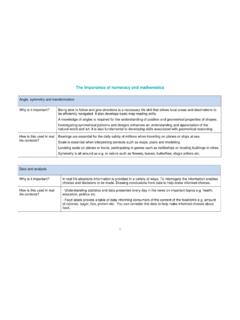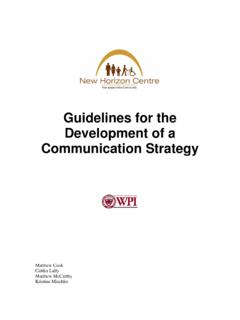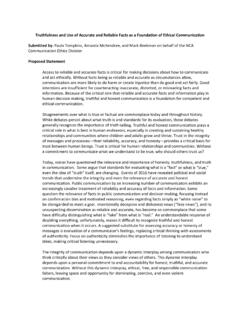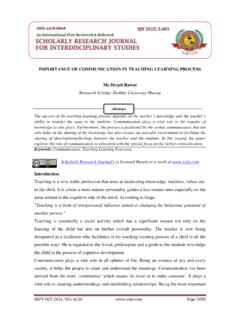Transcription of The human factor: the critical importance of effective ...
1 The human factor: the critical importance of effectiveteamwork and communication in providing safe careM Leonard, S Graham, D Saf Health Care2004;13(Suppl 1):i85 i90. doi: communication and teamwork is essential for thedelivery of high quality, safe patient care. Communicationfailures are an extremely common cause of inadvertentpatient harm. The complexity of medical care, coupled withthe inherent limitations of human performance, make itcritically important that clinicians have standardisedcommunication tools, create an environment in whichindividuals can speak up and express concerns, and sharecommon critical language to alert team members tounsafe situations.
2 All too frequently, effectivecommunication is situation or personality dependent. Otherhigh reliability domains, such as commercial aviation, haveshown that the adoption of standardised tools andbehaviours is a very effective strategy in enhancingteamwork and reducing risk. We describe our ongoingpatient safety implementation using this approach withinKaiser Permanente, a non-profit American healthcaresystem providing care for million patients. Wedescribe specific clinical experience in the application ofsurgical briefings, properties of high reliability perinatalcare, the value of critical event training and simulation, andbenefits of a standardised communication process in thecare of patients transferred from hospitals to skilled nursingfacilities.
3 Additionally, lessons learned as to effectivetechniques in achieving cultural change, evidence ofimproving the quality of the work environment, practicetransfer strategies, critical success factors, and the evolvingmethods of demonstrating the benefit of such work end of article forauthors to:Dr M Leonard, PhysicianLeader for Patient Safety,Patient Safety, One KaiserPlaza, 22nd Floor,Oakland, CA 94612,USA; failures are the leadingcauses of inadvertent patient medical care is delivered bymultiple team members, medical quality andsafety has historically been structured on theperformance of expert, individual communication and teamwork havebeen assumed, and formal training and assess-ment in these areas has been largely that the clinical care environmenthas become progressively more complex, com-bined with the inherent limitations of humanperformance.
4 Has spurred interest in applying thelessons of other high reliability industries development and implementation of crewresource management (CRM) in aviation overthe last 25 years offers valuable lessons formedical care. Realising that 70% of commercialflight accidents stemmed from communicationfailures among crew members, CRM sought tostandardise communication and , CRM is required globally in aviationtraining, and direct observational studies byRobert Helmreich s group have correlated actualflight crew performance with attitudes towardteamwork and safety. In 2000, we undertook theadoption of relevant behaviours and skills intohigh risk medical environments.
5 Twelve clinicalteams underwent a three day training pro-gramme in human factors; learning about thehuman factors experience in aviation, and theapplication of standard tools and behaviours toimprove safety and ensure effective communica-tion. The teams each worked on a clinical projectin which these techniques could be applied toimprove the quality and safety of patient clinical domains represented varied widelyfrom the operating room, the intensive care unit,and continuing care (the transfer of patientsfrom hospitals to skilled nursing facilities), toobstetrics and a cardiac treadmill the initial training, the clinical teamswere supported with site visits and educationalsessions for leadership and clinicians within thefacilities.
6 Cultural surveys with regard to safetywere carried out using the Safety AttitudeQuestionnaire (SAQ).1 Valuable insights intothe climate in these care areas with regard toteamwork, communication , and attitudes towardsafety were obtained. Gathering intimate knowl-edge of the specific culture allowed interventionsthat focused on the strengths of the team andtargeted opportunities for conference calls helped create a colla-borative community dedicated to improvingsafety, and to sharing successes and approachesto the inevitable experience has reinforced the belief thatsimple rules are best for managing complexenvironments.
7 The tools and concepts that haveproven the most valuable are collectively know asSBAR (situation, background, assessment,recommendation): a situational briefing model,appropriate assertion, critical language, andawareness and education regarding the fact thatnurses, physicians, and other clinicians aretaught to communicate in very different :CRM, crew resource management; OR,operating room; PIC, preferred intensity of care; SAQ,Safety Attitude on October 6, 2019 by guest. Protected by Saf Health Care: first published as on 1 October 2004. Downloaded from We will discuss these tools and our experiences in optimisingsuccessful implementation, and describe experiences inspecific clinical areas.
8 Other valuable concepts such assituational awareness and debriefing will be CASE FOR A PRIMARY FOCUS ON EFFECTIVETEAMWORK AND COMMUNICATIONC ommunication failures are the leading cause of inadvertentpatient harm. Analysis of 2455 sentinel events reported to theJoint Commission for Hospital Accreditation revealed thatthe primary root cause in over 70% was communicationfailure. Reflecting the seriousness of these occurrences,approximately 75% of these patients too often,clinicians providing care had very divergent perceptions ofwhat was supposed to happen. effective communication andteamwork is aimed at creating a common mental model, or getting everyone in the same movie.
9 Equally important iscreating an environment that feels safe to team membersso they will speak up when they have safety concerns. Themantra of everyone in the same movie, and no surprises isan effective one that is easy to teach. Clinicians understandthat surprises in medicine are generally not factors contribute to communication failures. Firstand foremost, doctors and nurses are trained to communicatequite differently. Nurses are taught to be very broad andnarrative in their descriptions of clinical situations ( paintthe big picture ), whereas physicians learn to be very concise,and get to the headlines quite quickly.
10 Nurses often relatebeing told during their educational process that they don tmake diagnoses . This leads to nurses telephoning physiciansand being very broad and narrative in their descriptions, withthe doctors impatiently waiting to find out what theywant . SBAR is very effective in bridging this difference incommunication styles and helping to get everyone in thesame movie. Hierarchy, or power distance, frequently inhibits peoplefrom speaking up. effective leaders flatten the hierarchy,create familiarity and make it feel safe to speak up andparticipate.


